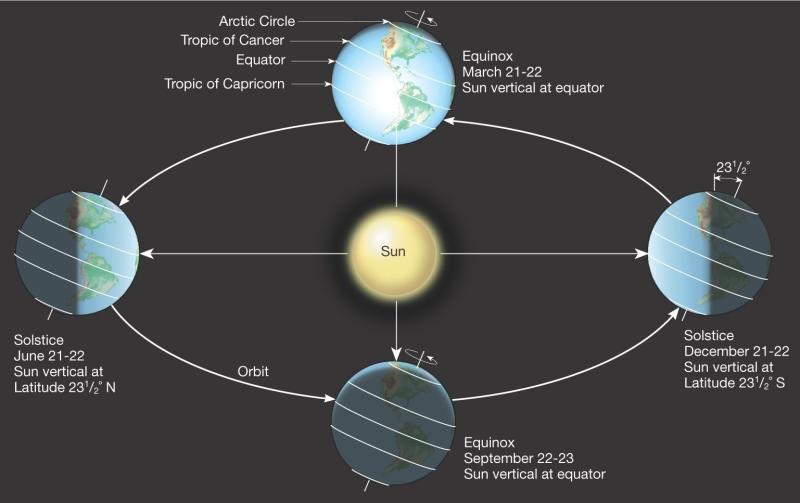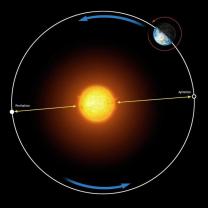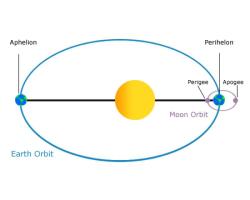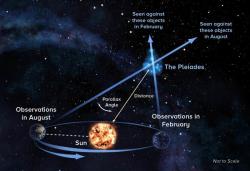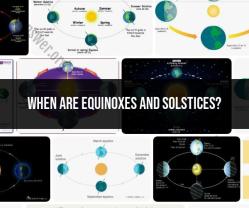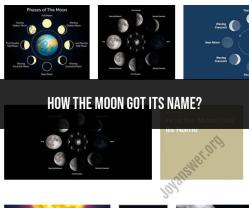When are days longer on an equinox or solstice?
The length of days during equinoxes and solstices is influenced by the tilt of the Earth's axis and its orbit around the Sun. Here's an explanation of when days are longer during equinoxes and solstices:
Equinoxes:
- Equinoxes occur twice a year, around March 20th (spring or vernal equinox) and September 22nd (fall or autumnal equinox). During these times, day and night are approximately equal in length all over the world. The word "equinox" itself means "equal night." On the equinoxes, the Sun is directly above the equator, and sunlight is evenly distributed between the Northern and Southern Hemispheres.
Solstices:
Solstices also occur twice a year, around June 21st (summer solstice) and December 21st (winter solstice). During a solstice, one hemisphere is tilted most toward the Sun (summer solstice) or away from the Sun (winter solstice). This tilt results in the longest day of the year during the summer solstice and the shortest day during the winter solstice.
In the Northern Hemisphere, the summer solstice (around June 21st) marks the longest day of the year, with the Sun reaching its highest point in the sky. Conversely, the winter solstice (around December 21st) marks the shortest day of the year.
In the Southern Hemisphere, the situation is reversed. The summer solstice (around December 21st) brings the longest day, while the winter solstice (around June 21st) results in the shortest day.
In summary, during the equinoxes, day and night are roughly equal in duration globally, while during the solstices, the length of the day is either at its maximum (summer solstice) or minimum (winter solstice) depending on the hemisphere's tilt toward or away from the Sun. The exact dates can vary by a day or two, but these general patterns hold true for most locations on Earth.
- Days are not longer on either equinox or solstice. In fact, equinoxes mark the days when day and night are roughly equal in length everywhere on Earth (except at the poles). On the other hand, solstices mark the extremes of day length:
- Summer solstice: Longest day of the year in the Northern Hemisphere, shortest day in the Southern Hemisphere.
- Winter solstice: Shortest day of the year in the Northern Hemisphere, longest day in the Southern Hemisphere.
- Equinoxes: Day length is nearly equal (around 12 hours) everywhere on Earth on equinoxes. However, it's not precisely 12 hours due to factors like atmospheric refraction and the Earth's slightly elliptical orbit.
Solstices: Day length varies significantly with latitude:
- Northern Hemisphere:
- Summer solstice: Day length increases as you move north, reaching 24 hours at the North Pole (continuous daylight).
- Winter solstice: Day length decreases as you move north, reaching 0 hours at the North Pole (continuous darkness).
- Southern Hemisphere: Opposite patterns occur, with longer days in the summer solstice and shorter days in the winter solstice.
- Cultural and historical significance: Many cultures have celebrated equinoxes and solstices for centuries, often associating them with changes in seasons, harvests, and spiritual beliefs. Here are some examples:
- Spring equinox: Associated with rebirth, renewal, and fertility in many cultures, like Ostara in Pagan traditions and Nowruz in Persian culture.
- Summer solstice: Celebrated as a time of peak sunlight and warmth, like Midsummer in Europe and Inti Raymi in the Inca Empire.
- Fall equinox: Seen as a period of transition and harvest, like Mabon in Pagan traditions and Thanksgiving in North America.
- Winter solstice: Marked as the shortest day and longest night, often associated with themes of light overcoming darkness, like Christmas in Christianity and Yule in various Pagan traditions.
These celebrations highlight the cultural significance of how day length changes throughout the year, with different societies weaving their own stories and traditions around these astronomical events.
